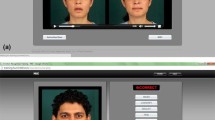Abstract
This study compared the ability of children with social phobia and children with no psychiatric disorder to accurately judge facial affect. Fifteen children and adolescents with social phobia and 14 control children were asked to identify emotions depicted in slides from the Pictures of Facial Affect. In addition, they rated their level of anxiety on a pictorial Likert scale prior to and upon completion of the facial recognition task. The results indicated that children with social phobia had significantly poorer facial affect recognition skills than normal controls and reported greater anxiety upon completion of the recognition task. Multivariate analysis revealed significant differences between groups in the number of errors based on the type of facial affect. Post-hoc analysis indicated that deficits were most pronounced for facial representations of happiness, sadness, and disgust. The results are discussed in relation to an integrated model of social skills training that includes facial affect recognition training as a integral component in treatment programs for children and adolescents with social phobia. Directions for future research with larger samples of more ethnically diverse children and adolescents are presented.
Similar content being viewed by others
References
American Psychiatric Association: Diagnostic and statistical manual of mental disorders (DSM-IV) (4th ed.). Washington, DC: American Psychiatric Association, 1994.
Beidel, DC, Turner, SM, Morris, TL: Psychopathology of childhood social phobia. J Amer Acad Child Adoles Psychiat 7: 73-77, 1997.
Beidel DC, Turner SM: Shy children, phobic adults: The nature and treatment of social phobia. Washington, DC: American Psychological Association Books, 1975.
Ekman P: Darwin and facial expressions: A century of research in review. New York: Academic Press, 1972.
Knapp M, Hall J: Nonverbal communication in human interaction. Fort Worth: Holt, Rinehart, and Winston, 1992.
David AS, Cutting JC: Affect, affective disorder, and schizophrenia: A neurological investigation of right hemisphere function. Brit J Psychiat 156: 491-495,1990.
Feinberg T., Rifkin A, Schaffer C, Walker E: Facial discrimination and emotional recognition in schizophrenia and affective disorders. Arch Gen Psychiat 43: 276-279, 1986.
Gur RC, Erwin RJ, Gur RE, Zwil AS, Heimberg C, Kraemer HC: Facial emotion discrimination: Behavioral findings in depression. Psychiat Res 42: 241-251, 1992.
Rubinov DR, Post, RM: Impaired recognition of affect in facial expression in depressed patients. Bio Psychiat 31: 947-953, 1992.
Zuroff DC, Colussy SA: Emotion recognition in schizophrenic and depressed inpatients. J Clin Psych 42: 411-416, 1986.
Walker E, Marwitt SJ, Emory E: A cross sectional study of emotional recognition in schizophrenics. J Abn Psych 89: 423-436, 1980.
Walker E: Emotion recognition in disturbed and normal children: A research note. J Child Psych Psychiat 22: 263-268,1981.
Silverman W, Albano AM: The Anxiety Disorders Interview Schedule for Children (DSM-IV). New York: Greywind Publications, 1996.
Beidel DC, Turner SM, Morris TL: A new instrument to assess childhood social anxiety and phobia: The Social Phobia and Anxiety Inventory for Children. Psych Assess 10: 73-79, 1995.
Eysenck HJ, Eysenck SBG: Manual for the Junior Eysenck Personality Inventory. San Diego: Educational and Industrial Testing Service, 1968.
Ekman P, Friesen WV: Pictures of facial affect [slides]. Palo Alto, CA: Consulting Psychologists Press, 1976.
Holder HB, Kirkpatrick SW: Interpretation of emotion from facial expressions of children with and without learning disabilities. J Learn Disabil 24: 170-177, 1991.
Guthrie PT, Smouse AD: Perceptions of emotions and attribution of acceptance by normal and emotionally disturbed children. J Nonverbal Beh 5: 253-263, 1981.
Author information
Authors and Affiliations
Rights and permissions
About this article
Cite this article
Simonian, S.J., Beidel, D.C., Turner, S.M. et al. Recognition of Facial Affect by Children and Adolescents Diagnosed with Social Phobia. Child Psychiatry Hum Dev 32, 137–145 (2001). https://doi.org/10.1023/A:1012298707253
Issue Date:
DOI: https://doi.org/10.1023/A:1012298707253




